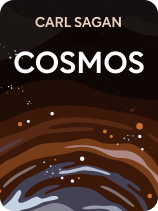

This article is an excerpt from the Shortform book guide to "Cosmos" by Carl Sagan. Shortform has the world's best summaries and analyses of books you should be reading.
Like this article? Sign up for a free trial here .
Is interstellar space travel feasible? What did the late Carl Sagan think about space travel?
In his book Cosmos, the late astronomer Carl Sagan spoke about the possibility of interstellar space travel. He believed that it may be possible in the future with the use of nuclear fusion technology. He also said that we would likely need to use multigenerational spacecrafts if we wanted to make any significant progress.
Here’s what Carl Sagan had to say about space travel.
Beyond Our Solar System
Even with the ability for travel within our solar system being limited, Sagan points out that humans still dream of going further, and he thinks we always will. Since we haven’t found any evidence of a habitable environment within our solar system, might there be some in other solar systems?
We don’t know how many planetary systems might exist in the cosmos. Sagan says the evidence suggests that almost all single stars like the sun should have satellite planets, but we can’t see them because the light of the stars is too bright. He says scientists are working on telescope technology that could dim the light so they might be able to see the much smaller objects orbiting the stars. Also, he says that in addition to “planets” orbiting stars, Jupiter, Saturn, and Uranus all have satellite “moons” that are planet-like, so many other planets could have such satellites as well. So there are innumerable possibilities for other worlds that could sustain life.
| Discovery of Exoplanets The technology that’s needed to observe exoplanets (planets orbiting stars outside of our solar system) now exists. The first exoplanet was observed in 1995, orbiting a star called Pegasus 51, about 50 light-years away from Earth. Since then, astronomers have discovered at least 4,000 more exoplanets in the Milky Way galaxy. Astrophysicist Hakeem Oluseyi says that the more scientists discover about the universe, the more likely they believe it is that life exists elsewhere. Scientists now estimate that there are about 2 trillion galaxies in the universe; Oluseyi believes this makes the odds very high that there is intelligent life out there somewhere. However, he still thinks we’re a very long way away from being able to travel or even communicate across this kind of distance. |
Interstellar Space Travel
Alpha Centauri is the closest “star” to us, being 4.3 light-years away, but Sagan explains that it’s actually a triple star system. Considering the vast distance, will it ever be possible to travel to other solar systems? Sagan suggests that nuclear fusion technology might make it possible to power spacecraft fast enough. However, he explains that such technology would require the spacecraft to be launched from Earth’s orbit, rather than from land, because of the dangers involved with the nuclear fusion reaction.
| Nuclear Fusion Technology In 2022, a panel of experts speaking at a meeting of the International Atomic Energy Agency discussed how advancements in nuclear fusion technology could soon be used to propel faster space travel. They say that rockets would have to lift off from earth using traditional fuel, but then once in space, the nuclear power could take over, and the technology currently available could cut travel time to Mars by 25%. Currently it takes about 7 months to reach Mars. Additionally, this nuclear technology could be used as a sustainable power source for extraterrestrial settlements, should we have the ability to create a long-term human habitation on Mars or another planet. Potentially, this kind of technology could power such a station for decades. |
Sagan says the technology to build a ship that can travel anywhere close to light-speed is probably thousands of years away, but a ship using nuclear fusion technology may be able to travel about 10% the speed of light. With Alpha Centauri being 4.3 light-years away, a voyage there would take 43 years, meaning it would be feasible for humans to travel there within a lifetime. But he proposes that to travel any further, we might need “multigenerational” spacecraft, where generations of humans would be born and live their lives, so that subsequent generations might reach other solar systems.
Considering the scientific discoveries being made in Ionia over 2,000 years ago, Sagan believes that we might be there right now if that scientific inquiry had not been suppressed by religious forces for centuries.
| Generation Ships The hypothetical concept of multigenerational space travel is something astronomers have pondered for decades, and some have undertaken serious research into the idea. They call such a vehicle a “generation ship.” A 2019 article by an international team of scientists addressed some of the practical questions concerning the development of a generation ship, such as how many people it would require, how large the ship would need to be, and how food would be produced. They determined that such an endeavor would require a crew of at least 98 people, to avoid genetic issues with inbreeding; they suggested around 500 people optimally. Based on a proposed cylindrical shape, they said the ship would need to be around 1,050 feet long and735 feet in radius, which they point out is still smaller than the world’s largest building. The experts also devised a plan for food involving cultivation in an artificially created plot of land that would need to be about 0.17 square mile in size. The only practical issue they haven’t yet worked out is how to have sufficient water. But, when that’s solved, they say the idea is quite feasible—given an adequate budget, which would need to be enormous. |
The Search for Extraterrestrial Life
The idea of intelligent life existing on other planets is probably the most powerful driving force of humanity’s interstellar space travel. It’s the theme of countless works of human imagination, from books and poetry to movies and television. Sagan believes the evidence would suggest it’s far more likely than not that there’s some kind of life out there in the universe; he says there could realistically be a hundred billion planetary systems in the galaxy, and each and every one of them would be unique.
According to Sagan, the same kind of evolutionary process that happened on Earth should logically operate everywhere in the universe. But with the number of possibilities of how that would unfold in a hundred billion unique environments, he thinks any life that may have evolved would probably be nothing like humans, or any kind of life we know.
(Shortform note: Carl Sagan’s 1985 novel Contact, which was used as the basis for a movie of the same name in 1997, explores this question. In one scene, a character asks another “Do you think there are people on other planets?” to which the reply is, “The universe is a pretty big place…so if it’s just us, seems like an awful waste of space.” While Sagan makes it clear that he doesn’t think life on other planets would be “people,” like us, this sentiment clearly reflects his own thoughts about the potential.)
Scientists have been intentionally trying to communicate with other potential life in the universe since the 1970s. Sagan says that we have the technology to communicate over interstellar distances; it’s called radio astronomy. Radio waves travel at the speed of light. The Arecibo Observatory in Puerto Rico has been searching continuously for any radio waves coming from outer space, and Sagan says that it once broadcast a message into space, directed toward a distant star cluster called M13.
| Sending Messages to the Stars That first interstellar message was broadcast in 1974 and contained binary-coded information, including a description of DNA and graphics of a stick-figure person, our solar system, and the telescope that sent the message. Several other messages in different forms have been sent since that time. The Arecibo telescope collapsed in 2020. In 2022, astronomers created an updated message that they’ve proposed to send out later in the year via two radio telescopes—one in China and one in northern California. That message includes a more sophisticated drawing of humans, a number of mathematical operations, a description of the Earth, and a detailed stellar map that shows the location of Earth—that last portion is controversial, as many believe it’s risky to broadcast our location without any idea of what/who might receive it. |
Humans have created many imagined scenarios in film and literature depicting the arrival of alien life on Earth. In pondering this possibility, Sagan says that one thing is clear: There’s no cause to worry about what we would do if extraterrestrial beings arrived here on Earth. Because if that happened, they’d be so technologically beyond us that there would be nothing we could do. He also hypothesizes that any species that has survived long enough to develop such technology has probably learned how to live effectively and peacefully with themselves and others, or they would have destroyed themselves already, as humans may be in danger of doing.
| Breakthrough Listen Physicist Stephen Hawking was both an enthusiastic supporter of searching for extraterrestrial life and very cautious about the idea of actually making contact. In 2015, Hawking helped to launch Breakthrough Listen, the most comprehensive program ever undertaken to explore interstellar space for messages or signs of life. The project aims to survey the 1 million closest stars to Earth, using radio and optical telescope technology. On the question of what we should do if we discover signs of life, Hawking advocated for quietly collecting as much information as possible, without revealing ourselves. He didn’t necessarily agree with Sagan’s sentiment about how extraterrestrials might approach us. He thought an extraterrestrial visit to Earth would likely have the same result for us that European colonization of the Americas had on the Native peoples. He said “we only have to look at ourselves to see how intelligent life might develop into something we wouldn’t want to meet.” |

———End of Preview———
Like what you just read? Read the rest of the world's best book summary and analysis of Carl Sagan's "Cosmos" at Shortform .
Here's what you'll find in our full Cosmos summary :
- Carl Sagan's insights into some of the universe's biggest questions
- The history of astronomical discovery, from ancient Ionia to 1980
- Why humans will need “multigenerational” spacecrafts to explore space






